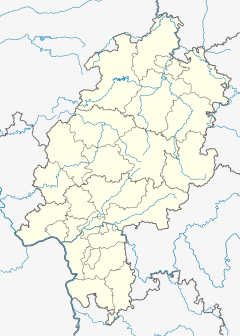Coleman Barracks
| Coleman Barracks | |||
|---|---|---|---|
| country | Germany | ||
| local community | Gelnhausen | ||
| Coordinates : | 50 ° 12 ' N , 9 ° 10' E | ||
| Opened | 1936 | ||
| Formerly stationed units | |||
| IX. Anti-tank division 4th Infantry Division 3rd Armored Division |
|
||
|
Location of the Coleman barracks in Hesse |
|||
The Coleman barracks (not to be confused with the Coleman Barracks in Mannheim ) is a former barracks in the city of Gelnhausen .
history
After the seizure of power by the National Socialists sought army administration for a suitable site for a new barracks. She found this in the Herzbachtal west of the city of Gelnhausen, just outside the zone demilitarized by the Versailles Treaty . Construction began in 1933 and was completed in 1936; the barracks got the name Herzbachkaserne .
The barracks consisted of six three-storey buildings - five crew houses and an administration building with an officers' mess - a pond was created in the middle. The architecture was based on the medieval old town of Gelnhausen. Nine sandstone reliefs were created on the façades, depicting scenes from Germany's military history from the perspective of National Socialist ideology .
After the opening, the IX. Anti-tank department into the barracks. When the war began in 1939, the unit was relocated to the western front and later fought in the east against the Soviet Union; the barracks stood empty at that time. After the war, the US Army occupied the completely undamaged barracks. From 1951 units of the 4th Infantry Division were stationed here until they moved back to the USA and were replaced by the 3rd Panzer Division . Probably the most famous soldier of the Coleman barracks was the future Secretary of State of the United States Colin Powell , who was stationed here from 1958 to 1960. A street on the former barracks site is named after him today.
After the Cold War , the 3rd Panzer Division was disbanded and the barracks cleared in 1992. The last units from nearby Büdingen remained in the adjoining housing area built in the 1950s until 2006.
conversion
Numerous authorities moved into the empty barracks, including the Gelnhausen District Armed Forces Replacement Office, which is responsible for the entire Rhine-Main area.
Monument protection
The Coleman barracks as a whole is a cultural monument according to the Hessian Monument Protection Act .
